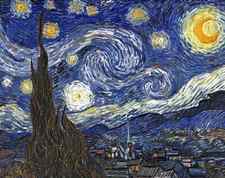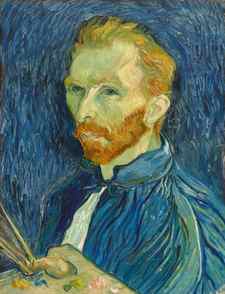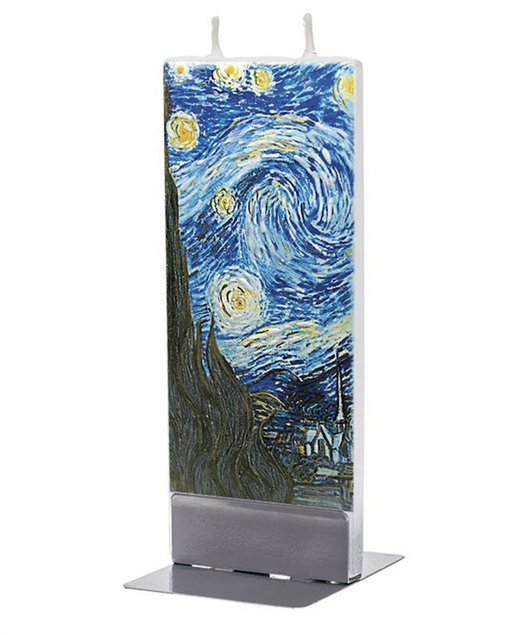The Starry Night has captivated viewers since its first display, even if its tortured artist, Vincent van Gogh, thought the painting was a failure. In painting, van Gogh found a way to say what he could never hope to say in words, expressing his extreme isolation in a society whose windows were darkened to him. Today, the work remains a masterpiece.
The Starry Night by Van Gogh
Many people believe The Starry Night is an expression of Van Gogh’s mental health. The vibrant blues are a common color during his bouts of mental illness. His fascination with stars, death, and transcendence are evident in the starry sky he painted.
What style of art is The Starry Night?
The Starry Night is Post-Impressionist art. It follows the Post-Impressionist style, with its focus on nature depicted through color and light. It also includes symbolism that expresses the artist’s feelings toward the subject.
What aesthetic is The Starry Night?
The aesthetics of The Starry Night are most evident in the sky. Van Gogh painted it with short, circular brushstrokes of vibrant blue. He used bright white and yellow for the circular stars. The brushstrokes are also evident in the large cypress tree, which has been described as flame-like.
What does The Starry Night symbolize?
The Starry Night symbolizes Van Gogh’s deteriorating mental state. It also symbolizes his connection to nature and his interest in traveling to the stars through death.
Table of Contents
- The Starry Night
- The Starry Night Aesthetic
- The Starry Night Analysis
- Facts About The Starry Night
- Lesson Summary
The Starry Night
The Starry Night by Vincent Van Gogh
The Starry Night was painted by Vincent Van Gogh in 1889. Although it is one of his most famous works, it was not recognized as a masterpiece during his lifetime. Van Gogh himself felt the painting was a failure. However, since it was purchased in 1941 by The Museum of Modern Art in New York City, it has become one of the most loved pieces of art of all time.
Who Made The Starry Night?
Vincent Van Gogh was a Dutch painter who lived from 1853 to 1890. He is known as a deeply troubled artist who struggled with mental illness. But he was also hardworking, creating 900 paintings in his short ten-year career. He was generally self-taught, although he did spend time painting and corresponding with other artists, such as Gaugin and Bernard. His brother Theo supported his art, even though his family did not recognize his genius. Like many Post-Impressionist artists, he was drawn to nature and painted “en plein air.” He moved to Paris to learn about Neo-Impressionism and Pointillism. He completed many paintings in Paris; however, his declining mental health resulted in him cutting off part of his ear. After this incident, he voluntarily admitted himself to an asylum, where he was able to obtain treatment. The asylum allowed him to walk outdoors with a chaperone and paint in a private studio room. He completed many paintings at the asylum, including The Starry Night. Although it is recognized as one of his best works, he was unhappy with the painting because he preferred to paint from real life, not from his imagination.
This is the St. Paul de Mausole asylum, where Vincent Van Gogh painted The Starry Night.
To unlock this lesson you must be a Study.com Member.
Create your account
Description of the Painting
Painted by Vincent van Gogh just months before his tragic suicide, The Starry Night is perhaps his greatest masterpiece. In the work, van Gogh portrays a nameless European village amidst a dark wilderness, complete with dampened lights. Some buildings manage to emit just enough light to be noticed, but others, including, notably, the church, are dark and unwelcoming. However, the real action is what is going on above the town, where the moon and stars light up the sky. Light moves across the sky in great sweeps and strokes, defeating the dark sky wherever it is encountered.
However, the stars are not enough to light up the whole sky, and between the viewer, the town, and the stars, there are vast fields of dark blue, a constant reminder of the depression and fear felt throughout the artist’s life. Despite the best efforts of the stars above and the town below, the darkness still is not completely overcome.

An error occurred trying to load this video. Try refreshing the page, or contact customer support.
The Starry Night
While every effort has been made to follow citation style rules, there may be some discrepancies. Please refer to the appropriate style manual or other sources if you have any questions.
Select Citation Style
Copy Citation
Share
Share
Share to social media
Give Feedback
External Websites
Feedback
Thank you for your feedback
Our editors will review what you’ve submitted and determine whether to revise the article.
External Websites
- Khan Academy – Van Gogh, The Starry Night
- MoMA Learning – The Starry Night
- The Van Gogh Gallery – Vincent Van Gogh: Starry Night
- Art in Context – “Starry Night” van Gogh – Exploring the Famous “Starry Night” Painting
Print Cite
verifiedCite
While every effort has been made to follow citation style rules, there may be some discrepancies. Please refer to the appropriate style manual or other sources if you have any questions.
Select Citation Style
Copy Citation
Share
Share
Share to social media
Feedback
External Websites
Feedback
Thank you for your feedback
Our editors will review what you’ve submitted and determine whether to revise the article.
External Websites
- Khan Academy – Van Gogh, The Starry Night
- MoMA Learning – The Starry Night
- The Van Gogh Gallery – Vincent Van Gogh: Starry Night
- Art in Context – “Starry Night” van Gogh – Exploring the Famous “Starry Night” Painting
Written by
Alicja Zelazko
Alicja Zelazko is Associate Editor, Arts and Humanities, covering topics in the visual arts, architecture, music, and performance. Before joining Encyclopædia Britannica in 2017, she worked at the Art.
Alicja Zelazko
Fact-checked by
The Editors of Encyclopaedia Britannica
Encyclopaedia Britannica’s editors oversee subject areas in which they have extensive knowledge, whether from years of experience gained by working on that content or via study for an advanced degree. They write new content and verify and edit content received from contributors.
The Editors of Encyclopaedia Britannica
Last Updated: Sep 13, 2023 • Article History
Table of Contents
Category: Arts & Culture

The Starry Night, a moderately abstract landscape painting (1889) of an expressive night sky over a small hillside village, one of Dutch artist Vincent van Gogh’s most celebrated works.
The oil-on-canvas painting is dominated by a night sky roiling with chromatic blue swirls, a glowing yellow crescent moon, and stars rendered as radiating orbs. One or two cypress trees, often described as flame-like, tower over the foreground to the left, their dark branches curling and swaying to the movement of the sky that they partly obscure. Amid all this animation, a structured village sits in the distance on the lower right of the canvas. Straight controlled lines make up the small cottages and the slender steeple of a church, which rises as a beacon against rolling blue hills. The glowing yellow squares of the houses suggest the welcoming lights of peaceful homes, creating a calm corner amid the painting’s turbulence.
Britannica Quiz
Ultimate Art Quiz

Van Gogh painted The Starry Night during his 12-month stay at the Saint-Paul-de-Mausole asylum near Saint-Rémy-de-Provence, France, several months after suffering a breakdown in which he severed a part of his own ear with a razor. While at the asylum, he painted during bursts of productivity that alternated with moods of despair. As an artist who preferred working from observation, van Gogh was limited to the subjects that surrounded him—his own likeness, views outside his studio window, and the surrounding countryside that he could visit with a chaperone.
Although van Gogh’s subjects were restricted, his style was not. He experimented with the depiction of various weather conditions and changing light, often painting the wheat fields nearby under a bright summer sun or dark storm clouds. Van Gogh was also particularly preoccupied by the challenges of painting a night landscape and wrote about it not only to his brother, Theo, but to a fellow painter, Émile Bernard, and to his sister, Willemien. In a letter addressed to the latter, he alleged that night was more colourful than day and that stars were more than simple white dots on black, instead appearing yellow, pink, or green. By the time van Gogh arrived at Saint-Rémy, he had already painted a few night scenes, including Starry Night (Rhône) (1888). In that work, stars appear in bursts of yellow against a blue-black sky and compete with both the glowing gas lamps below and their reflection in the Rhône River.
At the asylum, van Gogh observed the night sky from his barred bedroom window and wrote a letter to Theo describing a magnificent view of the morning star very early one morning in the summer of 1889. Because he was not allowed to paint in his bedroom, he painted the scene from memory or possibly drawings and used his imagination for the small village that did not actually exist. Employing the expressive style he had developed during his stay in Paris in 1886–88, he applied the paint directly from the tube onto the canvas, creating thick impasto and intense hues. Ambivalent about working from his imagination, van Gogh eventually regarded the finished Starry Night as a failure, and Theo frankly indicated that the painting favoured style over substance.
The painting was one of van Gogh’s late works, as he committed suicide the following year. His artistic career was brief, comprising only 10 years, but it was very productive. He left more than 800 paintings and 700 to 850 drawings to his brother. When the Museum of Modern Art (MoMA) in New York City purchased The Starry Night from a private collector in 1941, it was not well known, but it has since become one of van Gogh’s most famous, if not one of the most recognized, works in the art history canon.
Frequently Asked Questions
Who painted The Starry Night?
The Starry Night was painted by Post-Impressionist artist Vincent van Gogh.
When was The Starry Night painted?
Van Gogh painted The Starry Night in 1889.
Where is The Starry Night located?
Since 1941, The Starry Night has been located at the Museum of Modern Art in New York City.
How much is The Starry Night worth?
This priceless masterpiece is valued at over $109 million.
Books About The Starry Night
Want to expand your knowledge about Vincent van Gogh and The Starry Night? Check out some of these books. (Making a purchase via Bookshop helps support independent bookstores.)
With each passing year, it seems as though The Starry Night is reaching more and more fans and inspiring new generations of artists. Today, the renowned work of art is a must-have visual for art lovers, whether that’s in the form of a beautiful wall hanging, an inspiring decal, or a quirky toy.
Van Gogh Action Figure

Decorative Decal

Charming Mug

Artsy Pillow

Eye-Catching Candle

Unique Wall Hanging

Museum Collection Puzzle

Luminous Umbrella

Ultimately, given its fascinating context, poignant history, and original aesthetic, it’s no wonder that The Starry Night has had such a transcendent impact on the world of art and, equally, on the world as a whole.
This article has been edited and updated.
Related Articles:
Kelly Richman-Abdou
Kelly Richman-Abdou is a Contributing Writer at My Modern Met. An art historian living in Paris, Kelly was born and raised in San Francisco and holds a BA in Art History from the University of San Francisco and an MA in Art and Museum Studies from Georgetown University. When she’s not writing, you can find Kelly wandering around Paris, whether she’s leading a tour (as a guide, she has been interviewed by BBC World News America and France 24) or simply taking a stroll with her husband and two tiny daughters.





